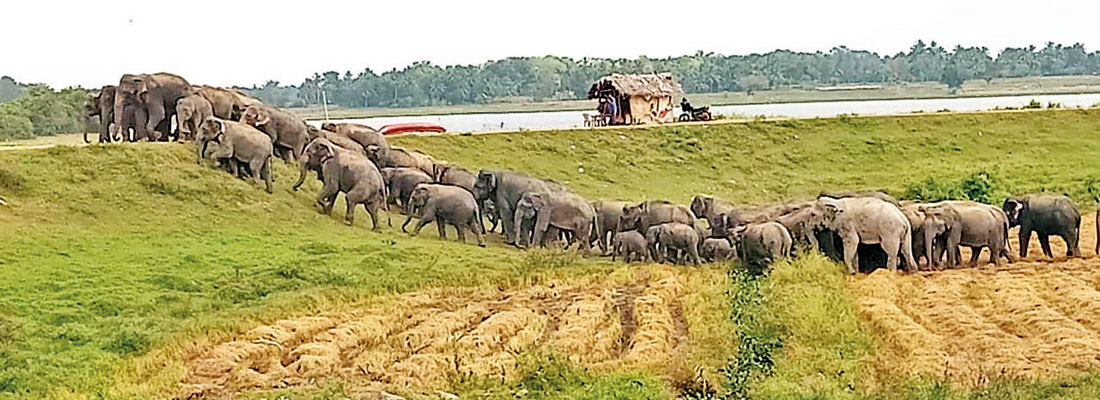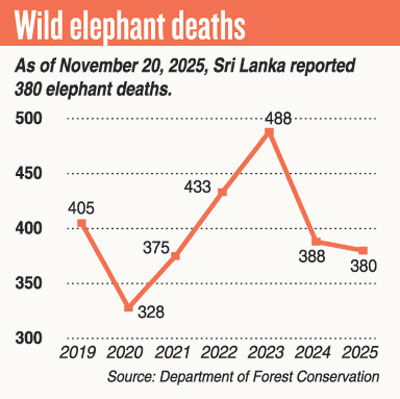News
Some ejected elephants return, but officials stick to plan
View(s):By Kasun Warakapitiya
The Department of Wildlife Conservation will continue the controversial elephant drives despite some setbacks, including animals returning to areas from which they are ejected.
This is because elephants prefer their home range over designated protected areas. Animals can’t be confined to certain areas, hoping they will adapt.
Wildlife officers said that despite setbacks and complications, they are under pressure from villagers, politicians and senior officials.

DWC Director General, Ranjan Marasinghe speaking at a news conference. Pic by Indika Handuwala
They said when complaints stack up, administrative authorities begin elephant drives, knowing that elephants would return.
They also explained the government’s people-centric approach also contradicts with animal welfare. A scientific approach is needed.
DWC officers said they experience behavioural changes of elephants during drives and know how they retaliate and become violent and hostile towards people. But drives continue.
The Sunday Times learned that the issue had also become politicised as both government and opposition groups are demanding a resolution while exaggerating the damage.
Wildlife officials who are tasked with protecting wild animals including elephants now have to drive them, to prevent harm to humans and to prevent humans from attacking animals.
A senior official of the Department of Wildlife Conservation who declined to be named confirmed elephant drives at Hambantota are continuing despite
several lawsuits.
According to him, the political ideology of being the “people’s government” plays a role in favouring the people rather than finding a solution.
The official admitted that the drives are a failed concept. He also added the animosity against elephants has increased. More elephants suffer gunshot injuries, and injuries from trying to eat food that disguise as Hakka Pattas (jaw breaker explosives).
DWC Director General, Ranjan Marasinghe said that as the issue remains unresolved, rushing for solutions could aggravate the issue.
He said the DWC is compelled to act because affected people pressure the government. He admits drives are not the best solution, but the elephants have to be chased away before villagers take matters into their own hands.
According to villagers in Hambantota, elephants are the real victims as their home ranges in Mattala have been taken over for projects, despite a Designated Managed Elephant Reserve (DMER).
They believe elephant reserves have been chosen without a proper study.

Elephants roaming the Samanthurai area. Pic by Ganasiri Hettiarachchige
They point out that research and a scientific approach is needed to determine where the animals would prefer to remain and thrive, so they would not attempt to enter human settlements.
Land set aside for elephants has been grabbed by villagers, businessmen as well as farmers.
Tissamaharama resident K.A Princy Surendra, told the Sunday Times that elephants remain displaced as their land was used for development projects during the time of the previous government.
He explained that the government is being deceived by wildlife officials who suggest temporary solutions.
“Though maps are marked and decisions made at the air-conditioned wildlife head office board room, when drives are carried out elephants do not behave as anticipated. The animals retaliate, run amok and run through villages and farmland,” Mr Surendra said.

Environmentalists blamed the government for changing its approach having agreed to a scientific approach to resolve the human elephant conflict.
Activist Sajeewa Chamikara from the Movement for Land and Agriculture Reform (MONLAR) said that the government promised a comprehensive research based, scientific approach in the manifesto “A Thriving Nation And Beautiful Life” and environmental policy “Mihikatha”. But, the government is following non-scientific methods.
“The unscientific elephant drives, which started from Kurunegala and failed, are now being carried out in the Anuradhapura and Hambantota Districts,” he said.
Mr. Chamikara predicted the human elephant conflict would tragically intensify.
According to him the main reason for the Hambantota elephant drive, is for the expansion of Magampura port, to create a Chinese industrial zone in the 8,000 acres allocated as well as well as to clear Walsapugala forest for solar power plants. He pointed out even though for decades attempts were made to drive elephants into an enclosed area, these were unsuccessful.

Environmentalists also suggested that the government should first declare the forested areas around the elephant management reserve as a part of the reserve, and open all the elephant corridors connecting other national parks such as Bundala, Lunugamvehera, and Udawalawe to the reserve.
Environment Minister Dammika Patabendi admitted that a scientific approach was needed.
Small scale elephant drives are done scientifically. Large-scale drives should be discontinued according to the National Action Plan for Human Elephant Conflict. He dismissed criticism of the DWC saying some are interpreting a small scale drive as a large scale one.
Mr Patabendi said the Hambantota elephant issue has its own set of complications as elephant territory had been taken for development projects and land had been allocated for a managed elephant reserve. The reserve would be gazetted again after studying elephant behaviour, their likings and other habitat within the reserve.
“We are having discussions at the ministry, we don’t want to rush this. There are complications. Some businessmen and farmers have been given land from
the reserve. We have to consider all that and see if the land provided is suitable,” he said.
| Tally of deaths to surpass 2024 The Director General of the Department of Wildlife Conservation, Ranjan Marasinghe admitted the number of elephant deaths this year would surpass the 388 deaths in 2024. To date this year, 380 elephants have perished. He told the Sunday Times that according to the elephant survey in 2024 there are at least 7,451 wild elephants and the population is stable. Animals are ageing as there are more mature animals and fewer young animals. According to him, the conflict with elephants has intensified as male elephant numbers including juvenile tuskers have increased. | |
The best way to say that you found the home of your dreams is by finding it on Hitad.lk. We have listings for apartments for sale or rent in Sri Lanka, no matter what locale you're looking for! Whether you live in Colombo, Galle, Kandy, Matara, Jaffna and more - we've got them all!

